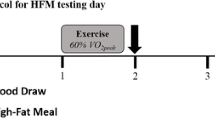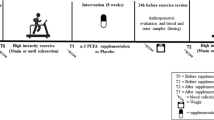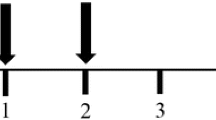Abstract
Purpose
Systemic inflammation is involved in the development of several diseases, including cardiovascular disease and type 2 diabetes. It is known that vigorous exercise affects systemic inflammation, but less is known about exercise at lower intensities. Hyperglycemia can also entail pro-inflammatory responses; however, postprandial hyperglycemia is blunted if the meal is followed by exercise. Hypotheses were: (1) moderate physical exercise acutely affects levels of C-reactive protein (CRP) and serum soluble vascular cell adhesion molecule 1 (sVCAM-1) in hyperglycemic individuals and (2) the effect depends on whether the activity is performed in a post-absorptive or postprandial state.
Methods
Twelve participants diagnosed with hyperglycemia, but not using anti-diabetic medication, underwent three test days in a randomized cross-over study; 1 control day without exercise, 1 day with 60 min of treadmill walking ending 30 min before breakfast, and 1 day with an identical bout of activity 30 min after the start of breakfast. Food intake was strictly standardized and venous blood for CRP, and sVCAM-1 analysis was sampled at standardized timepoints during the first 3.5 h after breakfast and once 24 h later.
Results
Merged data from the two exercise days showed that sVCAM-1 increased from baseline (4 ± 16 ng/mL) compared to the control condition (−28 ± 47 ng/mL, ES = 0.7, p = 0.024). There was no statistically significant difference in changes in sVCAM-1 levels between the two exercise test days. Exercise did not affect CRP values.
Conclusion
Moderate exercise increases sVCAM-1 in hyperglycemic individuals, whereas it does not affect CRP.



Similar content being viewed by others
Abbreviations
- BrEx:
-
Test day with exercise after breakfast
- CON:
-
Control day
- CRP:
-
C-reactive protein
- ES:
-
Effect size
- ExBr:
-
Test day with exercise before breakfast
- HbA1c:
-
Glycosylated hemoglobin
- HDL:
-
High density lipoprotein
- LDL:
-
Low density lipoprotein
- RPE:
-
Rate of perceived exertion
- sVCAM-1:
-
Soluble vascular cell adhesion molecule 1
References
Allen J, Sun Y, Woods JA (2015) Exercise and the regulation of inflammatory responses. Prog Mol Biol Transl Sci 135:337–354. doi:10.1016/bs.pmbts.2015.07.003
Bartzeliotou AI, Margeli AP, Tsironi M, Skenderi K, Bacoula C, Chrousos GP, Papassotiriou I (2007) Circulating levels of adhesion molecules and markers of endothelial activation in acute inflammation induced by prolonged brisk exercise. Clin Biochem 40:765–770. doi:10.1016/j.clinbiochem.2007.01.013
Borg GA (1982) Psychophysical bases of perceived exertion. Med Sci Sports Exerc 14:377–381
Brevetti G et al (2001) Exercise increases soluble adhesion molecules ICAM-1 and VCAM-1 in patients with intermittent claudication. Clin Hemorheol Microcirc 24:193–199
Ceriello A (2005) Postprandial hyperglycemia and diabetes complications: is it time to treat? Diabetes 54:1–7
Colberg SR, Zarrabi L, Bennington L, Nakave A, Thomas Somma C, Swain DP, Sechrist SR (2009) Postprandial walking is better for lowering the glycemic effect of dinner than pre-dinner exercise in type 2 diabetic individuals. J Am Med Assoc 10:394–397
Cook-Mills JM, Marchese ME, Abdala-Valencia H (2011) Vascular cell adhesion molecule-1 expression and signaling during disease: regulation by reactive oxygen species and antioxidants. Antioxid Redox Sign 15:1607–1638. doi:10.1089/ars.2010.3522
Dandona P, Chaudhuri A, Ghanim H, Mohanty P (2009) Insulin as an anti-inflammatory and antiatherogenic modulator. J Am Coll Cardiol 53:S14–S20. doi:10.1016/j.jacc.2008.10.038
Davis J, Murphy M, Trinick T, Duly E, Nevill A, Davison G (2008) Acute effects of walking on inflammatory and cardiovascular risk in sedentary post-menopausal women. J Sports Sci 26:303–309. doi:10.1080/02640410701552906
Derave W, Mertens A, Muls E, Pardaens K, Hespel P (2007) Effects of post-absorptive and postprandial exercise on glucoregulation in metabolic syndrome. Obesity (Silver Spring, Md) 15:704–711. doi:10.1038/oby.2007.548
Devlin JT, Horton ES (1985) Effects of prior high-intensity exercise on glucose metabolism in normal and insulin-resistant men. Diabetes 34:973–979
Emerging Risk Factors C et al (2010) C-reactive protein concentration and risk of coronary heart disease, stroke, and mortality: an individual participant meta-analysis. Lancet 375:132–140. doi:10.1016/S0140-6736(09)61717-7
Gabriel B, Ratkevicius A, Gray P, Frenneaux MP, Gray SR (2012) High-intensity exercise attenuates postprandial lipaemia and markers of oxidative stress. Clin Sci (Lond) 123:313–321. doi:10.1042/CS20110600
Goldberg RB (2009) Cytokine and cytokine-like inflammation markers, endothelial dysfunction, and imbalanced coagulation in development of diabetes and its complications. J Clin Endocrinol Metab 94:3171–3182. doi:10.1210/jc.2008-2534
Hopkins WG, Marshall SW, Batterham AM, Hanin J (2009) Progressive statistics for studies in sports medicine and exercise science. Med Sci Sports Exerc 41:3–13. doi:10.1249/MSS.0b013e31818cb278
Lakens D (2013) Calculating and reporting effect sizes to facilitate cumulative science: a practical primer for t-tests and ANOVAs. Front Psychol 4:863. doi:10.3389/fpsyg.2013.00863
Lara Fernandes J et al (2011) Acute and chronic effects of exercise on inflammatory markers and B-type natriuretic peptide in patients with coronary artery disease. Clin Res Cardiol 100:77–84. doi:10.1007/s00392-010-0215-x
Libby P, Crea F (2010) Clinical implications of inflammation for cardiovascular primary prevention. Eur Heart J 31:777–783. doi:10.1093/eurheartj/ehq022
Markovitch D, Tyrrell RM, Thompson D (2008) Acute moderate-intensity exercise in middle-aged men has neither an anti- nor proinflammatory effec.t. J Appl Physiol 105:260–265. doi:10.1152/japplphysiol.00096.2008
McArdle WD, Katch FI, Katch VL (2010) Exercise physiology. 7 edn. Wolters Kluwer, Lippincott Williams & Wilkins
Mendham AE, Donges CE, Liberts EA, Duffield R (2011) Effects of mode and intensity on the acute exercise-induced IL-6 and CRP responses in a sedentary, overweight population. Eur J Appl Physiol 111:1035–1045. doi:10.1007/s00421-010-1724-z
Monnier L, Colette C, Mas E, Michel F, Cristol JP, Boegner C, Owens DR (2010) Regulation of oxidative stress by glycaemic control: evidence for an independent inhibitory effect of insulin therapy. Diabetologia 53:562–571. doi:10.1007/s00125-009-1574-6
Nappo F et al (2002) Postprandial endothelial activation in healthy subjects and in type 2 diabetic patients: role of fat and carbohydrate meals. J Am Coll Cardiol 39:1145–1150
Nieman DC (1999) Nutrition, exercise, and immune system function. Clin Sports Med 18:537–548
Pigott R, Dillon LP, Hemingway IH, Gearing AJ (1992) Soluble forms of E-selectin, ICAM-1 and VCAM-1 are present in the supernatants of cytokine activated cultured endothelial cells. Biochem Biophys Res Commun 187:584–589
Price DT, Loscalzo J (1999) Cellular adhesion molecules and atherogenesis. Am J Med 107:85–97
Quagliaro L, Piconi L, Assaloni R, Da Ros R, Maier A, Zuodar G, Ceriello A (2005) Intermittent high glucose enhances ICAM-1, VCAM-1 and E-selectin expression in human umbilical vein endothelial cells in culture: the distinct role of protein kinase C and mitochondrial superoxide production. Atherosclerosis 183:259–267. doi:10.1016/j.atherosclerosis.2005.03.015
Sampson MJ, Gopaul N, Davies IR, Hughes DA, Carrier MJ (2002) Plasma F2 isoprostanes: direct evidence of increased free radical damage during acute hyperglycemia in type 2 diabetes. Diabetes Care 25:537–541
Semple SJ (2006) C-reactive protein—biological function, cardiovascular disease and physical exercise. South Afr J Sports Med 18:24–28
Semple SJ, Smith LL, McKune AJ, Neveling N, Wadee A (2004) Alterations in acute-phase reactants (CRP, rheumatoid factor, complement, Factor B, and immune complexes) following an ultramarathon. South Afr J Sports Med 16:17–21
Smith LL, Anwar A, Fragen M, Rananto C, Johnson R, Holbert D (2000) Cytokines and cell adhesion molecules associated with high-intensity eccentric exercise. Eur J Appl Physiol 82:61–67. doi:10.1007/s004210050652
Standl E, Schnell O, Ceriello A (2011) Postprandial hyperglycemia and glycemic variability: should we care? Diabetes Care 34(Suppl 2):S120–S127. doi:10.2337/dc11-s206
Weight LM, Alexander D, Jacobs P (1991) Strenuous exercise: analogous to the acute-phase response? Clin Sci (Lond) 81:677–683
Zuntz N (1901) Ueber die Bedeutung der verschiedenen Nahrstoffe als Erzeuger der Muskelkraft. Archiv fur die gesamte Physiologie des Menschen und der Tiere 83:557–571. doi:10.1007/BF01746509
Acknowledgements
We acknowledge Tine SA and Fjordland AS for supplying us with food for dietary standardization. Thanks to Kathrine Kroken and Olav Andreas Tuterud Nordølum for their contribution to the data sampling.
Author information
Authors and Affiliations
Corresponding author
Ethics declarations
Conflict of interest
The authors declare that they have no conflict of interest.
Ethical approval
All procedures performed were in accordance with the ethical standards of the institutional and/or national research committee and with the 1964 Helsinki declaration and its later amendments or comparable ethical standards.
Informed consent
Informed consent was obtained from all individual participants included in the study.
Additional information
Communicated by Fabio Fischetti.
Electronic supplementary material
Below is the link to the electronic supplementary material.
Rights and permissions
About this article
Cite this article
Nygaard, H., Falch, G.S., Whist, J.E. et al. Acute effects of post-absorptive and postprandial moderate exercise on markers of inflammation in hyperglycemic individuals. Eur J Appl Physiol 117, 787–794 (2017). https://doi.org/10.1007/s00421-017-3576-2
Received:
Accepted:
Published:
Issue Date:
DOI: https://doi.org/10.1007/s00421-017-3576-2




